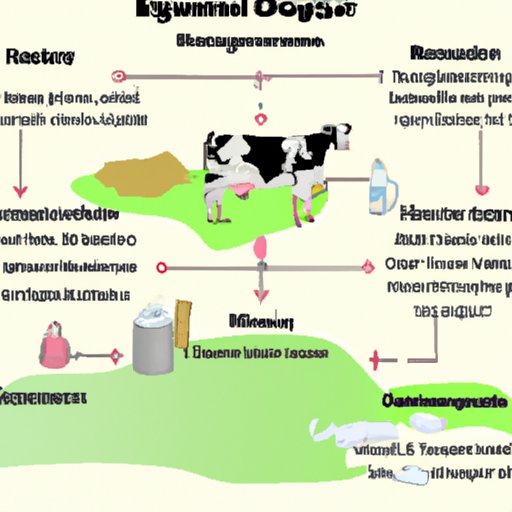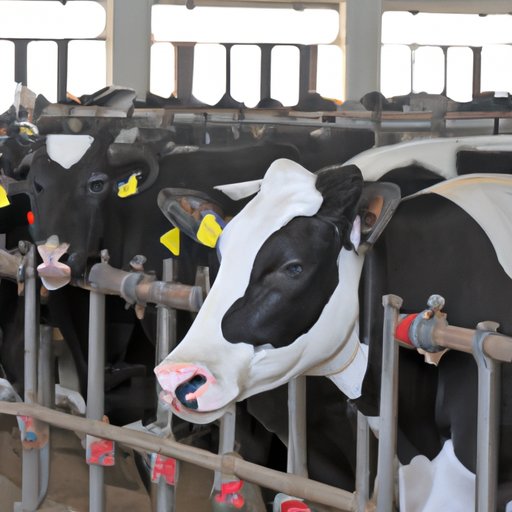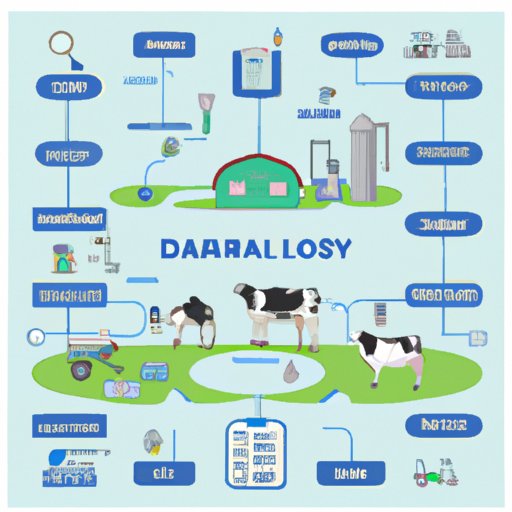Introduction
Organic dairy farming is a growing trend in the agricultural sector, providing consumers with fresh, nutrient-rich products that are free from synthetic pesticides and fertilizers. Starting an organic dairy farm requires extensive research and planning to ensure compliance with local regulations, develop a successful business plan, and select the right livestock and equipment. This comprehensive guide outlines all the steps needed to start an organic dairy farm.

Definition of Organic Dairy Farming
Organic dairy farming is the practice of producing milk, cream, cheese, butter, and other dairy products without the use of chemicals, hormones, or antibiotics. Organic farms also strive to reduce their environmental impact by utilizing sustainable practices such as crop rotation, composting, and integrated pest management.
Benefits of Organic Dairy Farming
Organic dairy farming offers numerous benefits to both consumers and producers. Consumers enjoy high-quality, chemical-free products that are rich in nutrients and flavor, while farmers benefit from increased demand for their products and higher prices due to the premium status of organic goods. Additionally, organic dairy farming can be more environmentally friendly than conventional methods, reducing water and air pollution.
Research and Understand Regulatory Requirements
Before starting an organic dairy farm, it is important to understand the regulations and licensing requirements in your area. In the United States, organic dairy farms must comply with the National Organic Program (NOP), which sets standards for production, handling, and labeling of organic products. It is also important to check with your state and local governments for additional regulations.
Licensing and Inspection Requirements
Organic dairy farms may require special licenses and inspections to ensure compliance with regulations. Depending on the size of the operation, you may need to obtain permits for land use, water use, and animal husbandry. You may also need to pass inspections from the Department of Agriculture or other regulatory agencies.
Develop a Business Plan
A detailed business plan is essential for any agricultural venture, and organic dairy farming is no exception. Your plan should include goals and objectives, startup costs, and a market analysis. Be sure to research the competition and potential customers in your area to determine the feasibility of your project.
Establish Goals and Objectives
Before beginning your business plan, decide what your goals and objectives are for the organic dairy farm. Consider factors such as profit margin, production capacity, and sustainability. Setting clear goals and objectives will help you stay focused and organized throughout the planning process.
Calculate Startup Costs
Startup costs can vary greatly depending on the size and scope of your operation. Make sure to include all expenses in your budget, including land and building purchases, equipment and supplies, labor, feed, and insurance. Don’t forget to factor in licensing fees and other regulatory costs.
Analyze the Market
It is important to analyze the market before launching your organic dairy farm. Research the competition in your area and identify potential customers. Consider how your product will fit into the existing market and how you can differentiate your farm from the competition.
Acquire Land and Buildings
Once you have developed a business plan, you can begin the search for suitable land and buildings. Look for properties with access to water, adequate fencing, and enough space for pasture, barns, and other structures. Consider construction and renovation costs when making your decision.
Find Suitable Locations
When selecting land for your organic dairy farm, look for locations with fertile soil, ample rainfall, and access to water. Avoid areas prone to flooding or drought and make sure the land is suitable for the type of crops you plan to grow. Check with local officials to ensure you meet zoning requirements.
Consider Construction and Renovation Costs
If you are purchasing an existing property, you may need to invest in renovations or new construction. Consider the cost of adding or replacing barns, fences, and other structures. If you are constructing new buildings, make sure they are designed to meet local regulations and accommodate your livestock.

Choose Appropriate Dairy Cattle Breeds
When selecting dairy cattle for your farm, consider the breed characteristics and your specific needs. Different breeds have different milk yields, disease resistance, and hardiness. Research each breed to find the best option for your climate and production goals.
Review Breed Characteristics
Each dairy cattle breed has its own unique characteristics. Review the age of maturity, milk yield, calving rate, and other traits to determine which breed is best suited to your operation. Consider the climate in your area and the availability of feed and other resources.

Select Breeds Based on Needs
Once you have reviewed the characteristics of various breeds, make your selection based on your specific needs. Choose breeds that are well-suited to your climate and production goals. Consider the availability of feed and other resources, as well as the cost of acquiring and maintaining the livestock.
Design Feeding and Management Strategies
Developing a feeding and management program is essential for the success of your organic dairy farm. Determine the sources of your feed, create rations for your animals, and develop animal care programs. Consider the nutritional needs of your livestock, as well as any regulations regarding organic feed.
Determine Feed Sources
When designing your feeding program, decide where you will source your feed. Consider growing your own feed, buying from local suppliers, or purchasing certified organic feed. Make sure to factor in the cost and availability of feed when developing your program.
Create Feed Rations
Once you have determined your feed sources, create rations for your animals. Consider the nutritional needs of your livestock, as well as the cost and availability of feed. Be sure to adjust your rations as needed during different seasons and stages of production.
Develop Animal Care Programs
Organic dairy farms are required to provide humane treatment for their livestock. Develop animal care programs that ensure the health and safety of your animals. Include procedures for housing, cleaning, grooming, milking, and other activities.

Invest in Quality Equipment and Supplies
High-quality equipment and supplies are essential for any successful organic dairy farm. Identify the essential equipment you need for milking, housing, and other activities. Outline the necessary supplies, including feed, bedding, and veterinary supplies.
Identify Essential Equipment
Some of the essential equipment needed for organic dairy farming includes milking machines, feeders, waterers, shelters, and other livestock management tools. Invest in quality equipment that is designed for your specific needs. Consider the cost and durability of different options.
Outline Necessary Supplies
In addition to equipment, you will need to purchase feed, bedding, and other supplies for your organic dairy farm. Make a list of everything you need, including hay, grain, salt blocks, vitamins, and veterinary supplies. Consider the cost and availability of different products.
Conclusion
Starting an organic dairy farm requires extensive research and planning. It is important to understand the regulations and licensing requirements in your area, develop a business plan, acquire land and buildings, choose appropriate dairy cattle breeds, design feeding and management strategies, and invest in quality equipment and supplies. By following these steps, you can ensure the success of your organic dairy farm.
(Note: Is this article not meeting your expectations? Do you have knowledge or insights to share? Unlock new opportunities and expand your reach by joining our authors team. Click Registration to join us and share your expertise with our readers.)
